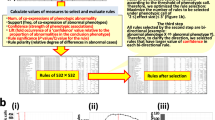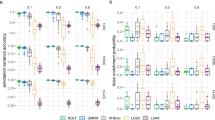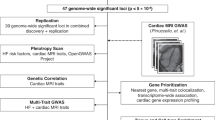Abstract
Cardiovascular disorders are influenced by genetic and environmental factors. The TIGR rodent expression web-based resource (TREX) contains over 2,200 microarray hybridizations, involving over 800 animals from 18 different rat strains. These strains comprise genetically diverse parental animals and a panel of chromosomal substitution strains derived by introgressing individual chromosomes from normotensive Brown Norway (BN/NHsdMcwi) rats into the background of Dahl salt sensitive (SS/JrHsdMcwi) rats. The profiles document gene-expression changes in both genders, four tissues (heart, lung, liver, kidney) and two environmental conditions (normoxia, hypoxia). This translates into almost 400 high-quality direct comparisons (not including replicates) and over 100,000 pairwise comparisons. As each individual chromosomal substitution strain represents on average less than a 5% change from the parental genome, consomic strains provide a useful mechanism to dissect complex traits and identify causative genes. We performed a variety of data-mining manipulations on the profiles and used complementary physiological data from the PhysGen resource to demonstrate how TREX can be used by the cardiovascular community for hypothesis generation.
This is a preview of subscription content, access via your institution
Access options
Subscribe to this journal
Receive 12 print issues and online access
$209.00 per year
only $17.42 per issue
Buy this article
- Purchase on Springer Link
- Instant access to full article PDF
Prices may be subject to local taxes which are calculated during checkout




Similar content being viewed by others
References
Hunter, D.J. Gene-environment interactions in human diseases. Nat. Rev. Genet. 6, 287–298 (2005).
Freimer, N. & Sabatti, C. The human phenome project. Nat. Genet. 34, 15–21 (2003).
Flint, J., Valdar, W., Shifman, S. & Mott, R. Strategies for mapping and cloning quantitative trait genes in rodents. Nat. Rev. Genet. 6, 271–286 (2005).
Jacob, H.J. & Kwitek, A.E. Rat genetics: attaching physiology and pharmacology to the genome. Nat. Rev. Genet. 31, 33–42 (2002).
Kwitek-Black, A.E. & Jacob, H.J. The use of designer rats in the genetic dissection of hypertension. Curr. Hypertens. Rep. 3, 12–18 (2001).
Tusher, V.G., Tibshirani, R. & Chu, G. Significance analysis of microarrays applied to the ionizing radiation response. Proc. Natl Acad. Sci. USA 98, 5116–5121 (2001).
Wildhirt, S.M. et al. Inducible nitric oxide synthase activation after ischemia/reperfusion contributes to myocardial dysfunction and extent of infarct size in rabbits: evidence for a late phase of nitric oxide-mediated reperfusion injury. Cardiovasc. Res. 43, 698–711 (1999).
Hoshikawa, Y. et al. Hypoxia induces different genes in the lungs of rats compared with mice. Physiol. Genomics 12, 209–219 (2003).
Grover, R.F., Vogel, J.H., Averill, K.L. & Blount, S.G. Jr. Pulmonary hypertension:individual species variability relative to vascular reactivity. Am. Heart J. 33, 1–3 (1963).
Molthen, R.C., Karau, K.L. & Dawson, C.A. Quantitative models of the rat pulmonary arterial tree morphometry applied to hypoxia-induced arterial remodeling. J. Appl. Physiol. 97, 2372–2384 (2004).
Madjdpour, C. et al. Decreased alveolar oxygen induces lung inflammation. Am. J. Physiol. Lung Cell. Mol. Physiol. 284, L360–L367 (2003).
Gibbs, R.A. et al. Genome sequence of the Brown Norway rat yields insights into mammalian evolution. Nature 428, 493–521 (2004).
Bailey, T.L. & Elkan, C. Fitting a mixture model by expectation maximization to discover motifs in biopolymers. Proc. Int. Conf. Intell. Syst. Mol. Biol. 2, 28–36 (1994).
Zan, Y. et al. Production of knockout rats using ENU mutagenesis and a yeast-based screening assay. Nat. Biotechnol. 21, 645–651 (2003).
Hubner, N. et al. Integrated transcriptional profiling and linkage analysis for identification of genes underlying disease. Nat. Genet. 37, 243–253 (2005).
Twigger, S.N. et al. Integrative genomics: in silico coupling of rat physiology and complex traits with mouse and human data. Genome Res. 14, 651–660 (2004).
de la Cruz, N. et al. The Rat Genome Database (RGD): developments towards a phenome database. Nucleic Acids Res. 33, D485–D491 (2005).
Zimdahl, H. et al. A SNP map of the rat genome generated from cDNA sequences. Science 303, 807 (2004).
Guryev, V., Berezikov, E., Malik, R., Plasterk, R.H. & Cuppen, E. Single nucleotide polymorphisms associated with rat expressed sequences. Genome Res. 14, 1438–1443 (2004).
Stoll, M. et al. A genomic-systems biology map for cardiovascular function. Science 294, 1723–1726 (2001).
Steen, R.G. et al. A high-density integrated genetic linkage and radiation hybrid map of the laboratory rat. Genome Res. 9, AP1–AP8 (1999).
Thomas, M.A., Chen, C.F., Jensen-Seaman, M.I., Tonellato, P.J. & Twigger, S.N. Phylogenetics of rat inbred strains. Mamm. Genome 14, 61–64 (2003).
Moreno, C. et al. Genomic map of cardiovascular phenotypes of hypertension in female Dahl S rats. Physiol. Genomics 15, 243–257 (2003).
Cui, Z.H. et al. Bronchial hyperresponsiveness, epithelial damage, and airway eosinophilia after single and repeated allergen exposure in a rat model of anhydride-induced asthma. Allergy 52, 739–746 (1997).
Rapp, J.P. Genetic analysis of inherited hypertension in the rat. Physiol. Rev. 80, 135–172 (2000).
Kuijpers, M.H. & de Jong, W. Spontaneous hypertension in the fawn-hooded rat: a cardiovascular disease model. J. Hypertens. Suppl. 4, S41–S44 (1986).
Cowley, A.W.J. et al. Brown Norway chromosome 13 confers protection from high salt to consomic Dahl S rat. Hypertension 37, 456–461 (2001).
Rozen, S. & Skaletsky, H. Primer3 on the WWW for general users and for biologist programmers. Methods Mol. Biol. 132, 365–386 (2000).
Malek, R.L. et al. Nrg-1 belongs to the endothelial differentiation gene family of G protein-coupled sphingosine-1-phosphate receptors. J. Biol. Chem. 276, 5692–5699 (2001).
Chen, Y.F., Durand, J. & Claycomb, W.C. Hypoxia stimulates atrial natriuretic peptide gene expression in cultured atrial cardiocytes. Hypertension 29, 75–82 (1997).
Acknowledgements
This work was funded by grants to N.H.L., J.Q. and H.J.J. from the National Heart, Lung, and Blood Institute's Programs for Genomic Applications. We would like to acknowledge V. Sheffield and S.E. Old for their support.
Author information
Authors and Affiliations
Corresponding author
Ethics declarations
Competing interests
The authors declare no competing financial interests.
Supplementary information
Supplementary Fig. 1
Quality control scatter plot (PDF 32 kb)
Supplementary Table 1
Differentially regulated genes between parental strains and consomic animals. (PDF 272 kb)
Supplementary Table 2
Differentially regulated genes averaged across SS-xBN consomic panel. (PDF 249 kb)
Supplementary Table 3
Differentially regulated genes averaged across all tissues within the SS-xBN panel. (PDF 249 kb)
Supplementary Table 4
Differentially regulated genes in hypoxic versus normoxic conditions. (PDF 255 kb)
Supplementary Table 5
Hemodynamic values and infarct size. (PDF 289 kb)
Supplementary Table 6
Correlation analysis statistics. (PDF 436 kb)
Supplementary Table 7
Real-time PCR and western blot variation of microarray data. (PDF 435 kb)
Supplementary Table 8
Promoter retrieval and MEME/MAST analysis. (PDF 254 kb)
Rights and permissions
About this article
Cite this article
Malek, R., Wang, Hy., Kwitek, A. et al. Physiogenomic resources for rat models of heart, lung and blood disorders. Nat Genet 38, 234–239 (2006). https://doi.org/10.1038/ng1693
Received:
Accepted:
Published:
Issue Date:
DOI: https://doi.org/10.1038/ng1693
This article is cited by
-
Wars2 is a determinant of angiogenesis
Nature Communications (2016)
-
Genetic divergence and the genetic architecture of complex traits in chromosome substitution strains of mice
BMC Genetics (2012)
-
Mapping genetic determinants of kidney damage in rat models
Hypertension Research (2012)
-
Chromosome substitution strains: gene discovery, functional analysis, and systems studies
Mammalian Genome (2012)
-
Repeatability of published microarray gene expression analyses
Nature Genetics (2009)



